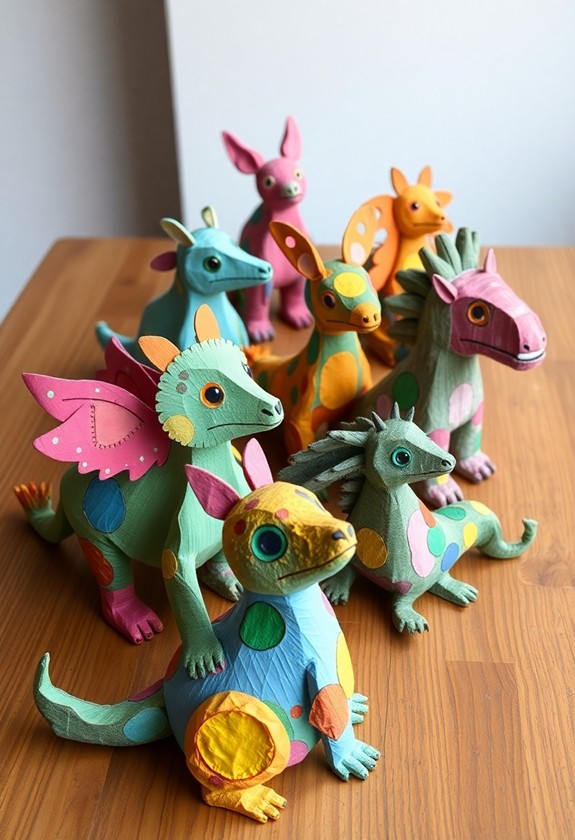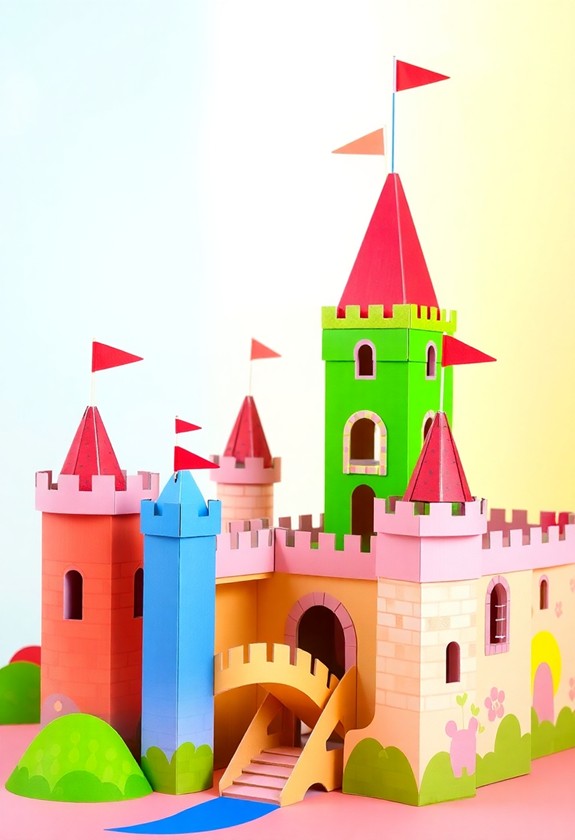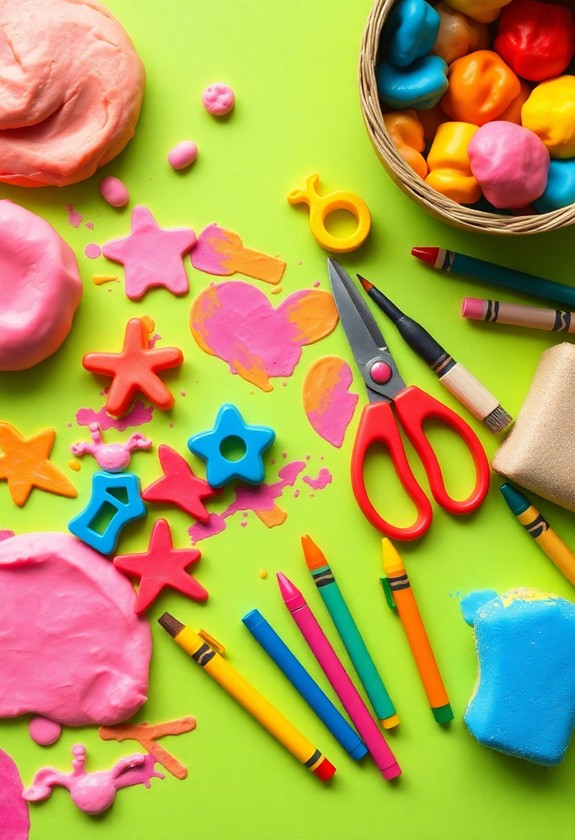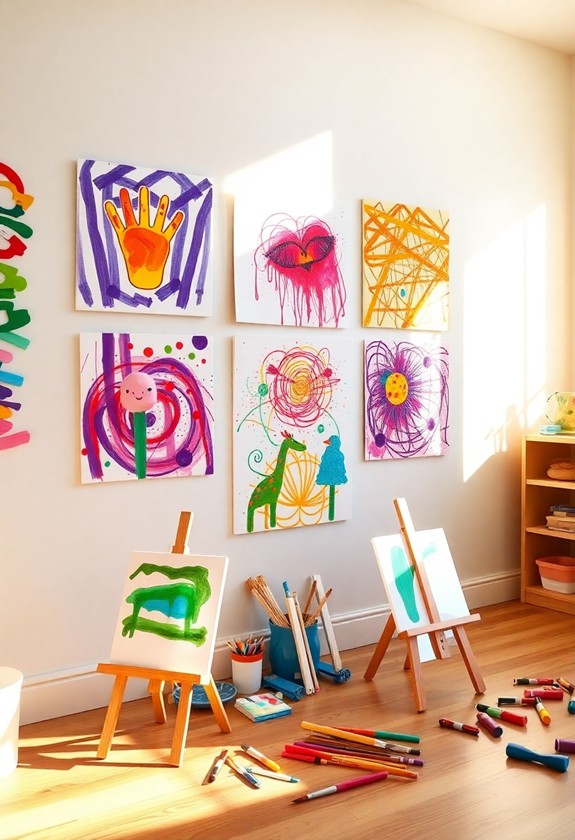Get ready to release your creativity with these 7 incredible 3D art activities that'll boost spatial skills! You'll love sculpting with clay, crafting paper mache masterpieces, and building intricate pipe cleaner structures. Don't forget the endless possibilities of cardboard box construction and the magic of origami folding! Playdough shape building is a hands-on delight, as 3D painting with textures adds depth to your artistic adventures. These fun-filled activities will improve fine motor skills, problem-solving abilities, and spatial awareness. Plus, they're perfect for all ages! Immerse yourself and watch your imagination soar as you investigate these exciting dimensional art projects. The expedition's just beginning!
Creative Highlights
- Clay sculpting enhances fine motor skills and spatial understanding through shaping and combining basic forms.
- Cardboard box construction develops problem-solving abilities and spatial awareness while creating diverse 3D structures.
- Origami folding improves hand-eye coordination and spatial skills by transforming 2D paper into 3D objects.
- Pipe cleaner structures promote spatial awareness and dexterity through building intricate designs and shapes.
- 3D painting with textures develops spatial skills by encouraging experimentation with layering and depth in artworks.
Clay Sculpting

Clay sculpting stands out among 3D art activities for its tactile and versatile nature. You'll love squishing, molding, and shaping this pliable material into amazing creations! It's a hands-on way to boost your spatial skills and release your creativity. Clay sculpting additionally enhances fine motor skills and cognitive development, making it an excellent activity for toddlers and young children.
Ready to get your hands dirty? Here's how to start:
- Gather your supplies: clay, tools, and a work surface
- Warm up the clay by kneading it
- Start with basic shapes: spheres, cubes, and cylinders
- Combine shapes to form more complex structures
- Use tools to add details and texture
Don't be afraid to experiment! Try sculpting animals, buildings, or even abstract forms. The possibilities are endless. As you work, you'll develop a better understanding of form, proportion, and spatial relationships. Plus, it's just plain fun to play with clay!
Paper Mache Creations

Moving from molding clay to shaping paper, let's explore the world of paper mache creations. You'll love getting your hands messy with this fun art form! It's super easy to get started:
- Tear newspaper into strips
- Mix flour and water to make a paste
- Dip strips into the paste
- Layer them over a balloon or form
Enhancing creativity and self-expression through various art forms, paper mache is an excellent way to develop fine motor skills in toddlers. This versatile medium additionally supports cognitive development as children problem-solve as they craft their 3D creations.
Voila! You're on your way to creating amazing 3D sculptures. But wait, there's more! Paper mache is so versatile. You can make masks, animals, or even a papier-mâché piñata! And talk about economical – it's cheap as chips!
Here are some cool project ideas:
- A paper mache planet
- A wacky monster mask
- A funky fruit bowl
Pipe Cleaner Structures

Three simple materials – pipe cleaners, imagination, and nimble fingers – are all you need to create fascinating 3D structures. It's time to twist, bend, and connect your way to spatial mastery! These colorful, flexible wires are perfect for building intricate shapes and designs. You'll be amazed at how quickly your creations come to life! Enhancing fine motor skills and nurturing creativity, pipe cleaner crafts are an excellent way for children to express themselves as they develop vital developmental skills.
Ready to plunge in? Here are some awesome ideas to get you started:
- Build a miniature cityscape with skyscrapers
- Create a playful forest of pipe cleaner trees
- Design your own jewelry with unique shapes
- Construct a futuristic spaceship or robot
- Craft a 3D portrait of your favorite animal
As you work, you'll develop fine motor skills and spatial awareness. Plus, it's just plain fun! So grab those pipe cleaners and let your creativity soar. Who knows what incredible structures you'll dream up?
Cardboard Box Construction

From the humble cardboard box springs forth a world of architectural possibilities. You'll be amazed at what you can create! With just a few simple tools and your imagination, you're ready to build incredible structures. This activity not only improves creativity and problem-solving but also promotes fine motor skills development. Here's how to get started:
- Gather materials: cardboard boxes, scissors, tape, and markers
- Sketch your design – dream big!
- Cut and shape your boxes
- Tape pieces together to form walls and roofs
- Add windows, doors, and fun details
Let your creativity soar! Build a castle with towering turrets, a futuristic space station, or a cozy cottage. The sky's the limit! As you construct your cardboard masterpiece, you're developing important spatial skills. You'll learn about balance, proportion, and how shapes fit together. Plus, it's a box-load of fun! So, what are you waiting for? Start building your cardboard kingdom today!
Origami Folding

Why limit yourself to three dimensions when you can explore the art of paper folding? Origami is an exciting way to boost your spatial skills and create amazing 3D objects from flat paper! It's like magic, but you're the magician! With just a few folds, you can transform a simple square into animals, flowers, or even intricate geometric shapes. For toddlers, creative art products can inspire endless fun and provide a foundation for origami skills. Ready to give it a try? Here are some fun origami projects to start with:
- Jumping frogs
- Paper airplanes
- Lotus flowers
- Cute penguins
- Colorful butterflies
Origami isn't just fun – it's brain food too! As you fold and crease, you're exercising your mind and improving your hand-eye coordination. Plus, it's a great way to practice patience and precision. So grab some paper and let's start folding! Who knows? You might just become the next origami master!
Playdough Shape Building

Whereas paper folding offers a structured approach to 3D creation, playdough shape building lets your imagination run wild! You'll love squishing, rolling, and molding this colorful clay into fantastic shapes. It's time to get your hands messy and have a blast!
Here's how to get started:
- Grab a chunk of playdough
- Knead it to warm it up
- Start shaping!
Try making:
- Animals (how about a dough-nut-loving elephant?)
- Buildings (a leaning tower of pizza, anyone?)
- Vehicles (vroooom!)
As you build, you're developing spatial skills and hand-eye coordination. Plus, it's just plain fun! Mix colors, add texture with tools, and let your creativity soar. Don't worry about perfection – the joy is in the process. So go ahead, sculpt your way to 3D mastery!
3D Painting With Textures

Plunge into the world of 3D painting with textures! It's time to get your hands messy and create some seriously cool art. You'll love investigating different materials to add depth and dimension to your paintings. But wait, there's more! This activity isn't just fun, it's furthermore great for developing your spatial skills.
Ready to jump in? Here's what you'll need:
- Canvas or thick paper
- Paint (acrylic works best)
- Brushes of various sizes
- Texture-making tools (sponges, combs, bubble wrap)
- Found objects (leaves, pebbles, twigs)
Now, let's get creative! Start by applying a base coat of paint. Then, use your tools to add texture. Drag a comb through wet paint for grooves, or press bubble wrap for a bubbly effect. Don't forget to experiment with layering! Your 3D masterpiece will be popping off the canvas in no time!
Curious Little Questions
At What Age Should Children Start Engaging in 3D Art Activities?
Ever wondered when your little one should plunge into the wonderful world of 3D art? You'll be thrilled to know it's never too early! Kids as young as 2 or 3 can start investigating simple 3D activities. But don't worry if you've waited – older kids can leap right in too! The key is to match the complexity to their age and skills. Start with playdough for toddlers, then progress to more intricate projects as they grow. It's all about fun and learning!
How Can 3D Art Activities Benefit Children With Learning Disabilities?
You'll be amazed at how 3D art activities can help kids with learning disabilities! These hands-on projects are like magic wands, boosting their:
- Fine motor skills
- Spatial awareness
- Problem-solving abilities
- Self-expression
Plus, they're fun! Whether it's sculpting, building with blocks, or creating paper mache masterpieces, these activities engage multiple senses. This multi-sensory approach can really help kids who struggle with traditional learning methods. It's like unlocking a secret door to their potential! So, get those creative juices flowing and watch them thrive!
What Safety Precautions Should Be Taken During 3D Art Activities?
You're about to set off on the most epic 3D art adventure ever! But hold your horses, safety first! Here's what you need to do:
- Wear protective gear: goggles, gloves, and aprons are your new best friends!
- Keep your workspace squeaky clean and clutter-free
- Use child-safe materials and tools
- Supervise younger artists like a hawk
- Have a first-aid kit handy, just in case
Are There Any Eco-Friendly Alternatives for 3D Art Materials?
You've got tons of eco-friendly options for 3D art materials. Try these awesome alternatives:
- Use recycled cardboard or paper mache for sculpting
- Create with natural clay or beeswax
- Collect twigs, leaves, and stones for nature-inspired projects
- Upcycle old toys or household items into art pieces
- Make your own play dough with kitchen ingredients
It's like giving Mother Nature a high-five as you create! Plus, you'll feel great knowing your art isn't harming the environment. Let's get crafty and green!
How Can Parents Encourage Reluctant Children to Participate in 3D Art Activities?
Did you know that 75% of kids who engage in 3D art show improved spatial skills? That's amazing! To get your reluctant child involved, try these fun tricks:
- Make it a game! Turn clay sculpting into a silly monster-making contest.
- Start small with easy projects they'll love, like building with blocks or Legos.
- Join in the fun! Kids love when parents get messy too.
- Praise their efforts, not just results. Every squiggly creation is a masterpiece!




